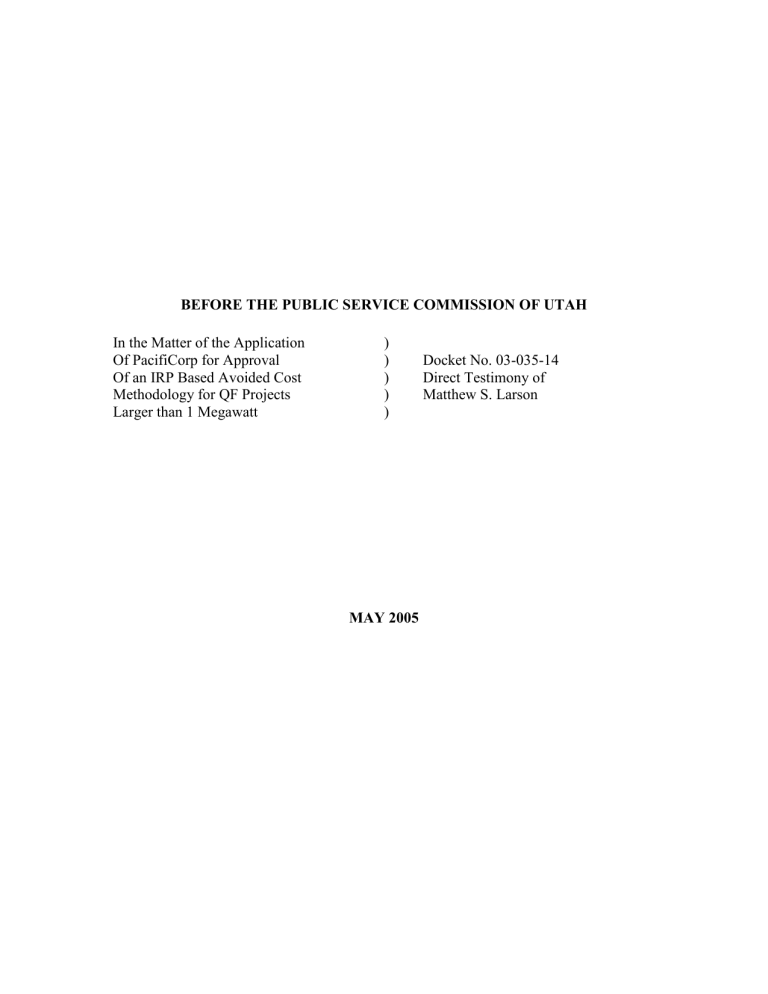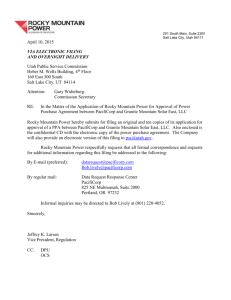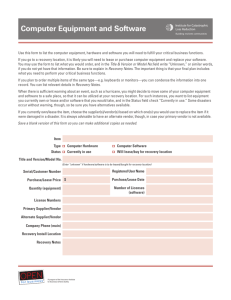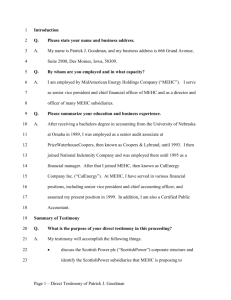Direct Testimony of Matthew Larson

BEFORE THE PUBLIC SERVICE COMMISSION OF UTAH
In the Matter of the Application
Of PacifiCorp for Approval
Of an IRP Based Avoided Cost
Methodology for QF Projects
Larger than 1 Megawatt
)
) Docket No. 03-035-14
) Direct Testimony of
) Matthew S. Larson
)
MAY 2005
15
16
17
12
13
14
18
10
11
8
9
19
20
21
22
23
3
4
1
2
5
6
7
Q.
Please state your name, business address and present position with PacifiCorp.
A.
My name is Matthew S. Larson. My business address is 825 N.E. Multnomah, Suite
600, Portland Oregon. I am a Principal Consultant in PacifiCorp’s Commercial and
Trading group.
Qualifications
Q.
Please briefly describe your education and business experience.
A.
I’ve been employed by PacifiCorp since November of 2003. Prior to that time, I was employed by Deloitte & Touche as a manager in their energy risk and assurance group based in Houston, TX. I earned my Bachelor of Science degree in business administration with a concentration in finance at Idaho State University. I am a
Certified Public Accountant.
Q.
In your position, have you been involved in an analysis of the impact of new accounting standards on PacifiCorp?
A.
Yes. In conjunction with our independent external auditors, I have reviewed the impact on PacifiCorp of Emerging Issues Taskforce (“EITF”) 01-8, entitled
“Determining Whether an Arrangement Contains a Lease” and Financial
Interpretation No. 46R (“FIN 46”), “Consolidation of Variable Interest Entities.”
Purpose of Testimony
Q.
What is the purpose of your testimony?
A.
The purpose of my testimony is to explain the impact of new accounting standards on
PacifiCorp’s financial statements as they relate to power purchase agreements with qualifying facilities (QFs) as a result of EITF 01-8 and FIN 46.
Page 1 – Direct Testimony of Matthew S. Larson
38
39
40
41
33
34
35
36
37
42
43
44
45
46
28
29
30
31
32
24
25
26
27
Q.
Would you please explain the financial statement impacts of the EITF 01-8 and
FIN 46 in relation to long-term power purchase agreements with QFs?
A. EITF 01-08 and FIN 46 address an issue commonly known as “off balance sheet financing.” The intent of these two independently applied standards is to provide better transparency to potential investors, shareholders and bondholders regarding the fixed obligations of an entity for financial reporting purposes. Under EITF 01-8,
PacifiCorp is required to review contracts with QFs executed or modified after July 1,
2003 to determine whether or not they contain a lease. If a lease exists it must be analyzed under Financial Accounting Standard 13 (“FAS 13”), Accounting for Leases to determine capital versus operating lease. If, after reviewing the contract under the
FAS 13 rules, it is determined to be a capital lease, then PacifiCorp would be required to record the contract as debt on its balance sheet with a corresponding capital lease asset on the balance sheet. When applied to QFs, FIN 46 could require the assets and liabilities of the QF to be consolidated on PacifiCorp’s books if it is determined that
PacifiCorp is the primary beneficiary. The determination of the primary beneficiary is a complex process that takes many factors into account. Exhibit UP&L___(MSL-
1) is a simplified illustration of how to apply EITF 01-8 and FIN 46 to QF purchase agreements.
Q.
What are the EITF 01-8 criteria?
A.
When fulfillment of a contract with a QF is dependent upon a specific plant and the contract allows the purchaser the ability or right to operate the plant, gives the purchaser control over physical access to the plant, or if it is unlikely that other parties will take more than a minor amount of output from the plant (10%), the lease
Page 2 – Direct Testimony of Matthew S. Larson
60
61
62
63
64
65
66
67
68
56
57
58
59
51
52
53
54
55
47
48
49
50 criteria of FAS 13 must be applied unless the price the purchaser pays is fixed per unit of output or priced at market per unit of output (to be interpreted strictly).
Q. What type of information would need to be provided by the QF for your analysis under EITF 01-8?
A. The following items are important factors for determining whether other parties will take more than a minor amount of the output of a facility. It should be noted that production tax credits and allowances such as green tags are not included in the analysis. i. Total expected output. ii. Amount of expected output others will purchase. iii. Evidence of their ability to sell to others. iv. Expected revenue from steam sales (if applicable). v. Support for their ability to sell steam (if applicable).
Q. What are the FAS 13 criteria?
A.
If a contract meets any one of the following conditions, it is considered a capital lease and a debt obligation is recorded on the purchaser’s books: i.
Ownership transfer at the end of term; ii.
Bargain purchase option; iii.
Term greater than 75 percent of the estimated economic plant life; or iv.
Net present value (NPV) of minimum lease payments less executory costs, discounted at lessee’s incremental borrowing rate is greater than or equal to 90 percent of asset fair value;
Page 3 – Direct Testimony of Matthew S. Larson
78
79
80
81
82
83
84
85
73
74
75
76
77
69
70
71
72
If a contract does not meet any of the above criteria then the contract is considered an operating lease and a debt obligation is not recorded on the purchaser’s books. The guidance under FAS 13 is mirrored by the FERC equivalent in 18 CFR, Pt. 101,
General Instructions, paragraph 19, Criteria for classifying leases .
Q. What type of information would need to be provided by the QF for your analysis under FAS 13?
A. The following items are important factors for determining whether a contract qualifies as a capital lease under FAS 13. i. Project cost to build (all encompassing).
ii. Project life in years (with support). iii. Executory & Non-Executory cost breakdown where Executory costs are costs such as insurance, maintenance, and taxes incurred for the property including profits.
Any cost that is not directly related to operating the plant, should be considered
Executory. iv. Engineering study showing expected life of asset.
Q. Does this conclude your testimony?
A. Yes.
Page 4 – Direct Testimony of Matthew S. Larson
S
How PPA Impacts Balance Sheet
PacifiCorp
Exhibit UP&L___(MSL-1)
Docket No. 03-035-14
Witness: Matthew S. Larson
FIN 46
VIE Test:
- Financing support required from other parties, or
- Equity investor lacks controlling financial interest? yes
Equity < expected losses, or
Buyer absorb majority of expected losses? yes
Could lead to seller deconsolidating VIE and buyer consolidating assets & liabilities
(including environmental) of VIE onto buyer’s books
Added liabilities could add to capital requirements to maintain structure
EITF 01-8 no
- Contract fulfillment is dependent upon specific plant and conveys right to use
- Purchaser takes majority of output & pricing not fixed or at market per unit of output yes
No FASB13 lease test
FASB 13 Lease Test
- Ownership transfer at end of term
- Bargain purchase option
- Term > 75% of useful life
- NPV of fixed pmt > 90% of asset fair value no
Operating Lease yes
Capital Lease
No debt added to buyers books.
Debt could be imputed by rating agencies.
Accounting debt added to books.
100% NPV of fixed payments (combination of FMV & interest expense)






